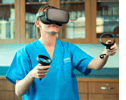Education & Training
Bow Valley College nursing students use VR
March 4, 2020
 CALGARY – A new lab at Bow Valley College in downtown Calgary allows nursing students to identify respiratory conditions using a virtual stethoscope. The virtual reality assessment tool was developed by the School of Health and Wellness and Calgary-based technology company ICOM Productions as part of the Practical Nurse Diploma program. Students have started using the lab this term.
CALGARY – A new lab at Bow Valley College in downtown Calgary allows nursing students to identify respiratory conditions using a virtual stethoscope. The virtual reality assessment tool was developed by the School of Health and Wellness and Calgary-based technology company ICOM Productions as part of the Practical Nurse Diploma program. Students have started using the lab this term.
The tool features nine different avatars ranging in age, ethnicity, and respiratory conditions. Learners are required to complete assessments on the virtual patients and to recognize normal from abnormal findings, which can sometimes take months in the work environment to develop proficiency.
The tool provides a realistic and complete experience, simulating patients in the hospital room. It also includes a grading component on infection protection and control techniques such as handwashing.
“The system uses a rubric that will track each learner’s assessment and generate a report of what was completed and what was not,” said Kim Hogarth, associate dean in the Practical Nursing program for the School of Health and Wellness.
“For example, if the learner misses certain landmarks while auscultating with a stethoscope, or does not listen to each full breath, the report will document this.”
Learners are required to complete documentation at the end of the evaluation to identify their findings and create a care plan for the patient.
Hogarth said the department is working with ICOM to integrate artificial intelligence into the virtual reality to enhance the grading process.
“Using AI to mark charting at the end of the scenario will allow for complete consistency throughout the entire scenario for all learners,” she said.
A recent pilot of the virtual reality assessment tool produced “very positive” findings, with learners becoming comfortable with the technology in about 10 to 15 minutes, Hogarth noted.
“It’s very user-friendly, and ICOM was able to use innovative ideas to reduce some of the common issues with VR, such as dizziness,” she said.
Hogarth said the new lab gives learners a chance to react to abnormal respiratory findings before they enter the clinical setting.
“With this technology and assessment, we can expose learners to abnormal findings earlier. We believe this will increase their confidence and competence earlier in the clinical setting,” she said.
The virtual environment combines factual aspects with audio clues, like the sounds that would be audible with common respiratory conditions.
“We can replicate tactile fremitus (psychomotor) using vibrations on discrete locations through the hand controllers,” Hogarth said.
Kristen Cameron, a second-year student in the Practical Nurse Diploma program, took part in the pilot project and found the assessment tool useful – particularly the chance to recognize abnormal sounds through a stethoscope.
“Most of our nursing classmates that we practice on have healthy lungs,” she said. “However, that is not reality for some of our patients and we need to be able to pick up on that. It was easy for me to recognize the abnormal sounds on auscultation, and I appreciated the experience.”
Cameron was assigned an avatar of a male patient with asthma and was able to hear wheezing and coarse crackles (rales), when she listened through the virtual stethoscope.
“I have never been into video games or (been) much of a techie person, so I was nervous about learning to operate the VR. My instructor was very helpful and I caught on quickly. Ensuring you are using the ‘teleport’ option and not moving or turning your body will help prevent dizziness.”
Jeff Clemens, program chair in the School of Creative Technologies, said the college is starting to use virtual reality as a way to get students immersed more deeply into what they are learning.
“The hope is that with this immersion we can increase their retention on some very important subjects and skills,” Clemens said.
The new virtual reality labs are located on the 6th and 7th floors of Bow Valley College’s North Campus. One features 11 dedicated learner-facing stations, in addition to two instructor stations, and another is a dedicated space for faculty development.
The five-term Practical Nurse Diploma program is offered over a continuous 20-month period. For more information, visit bowvalleycollege.ca/VRlab.
